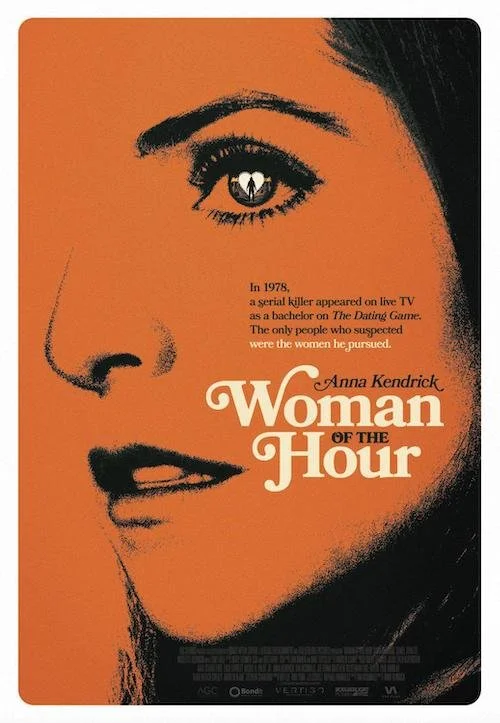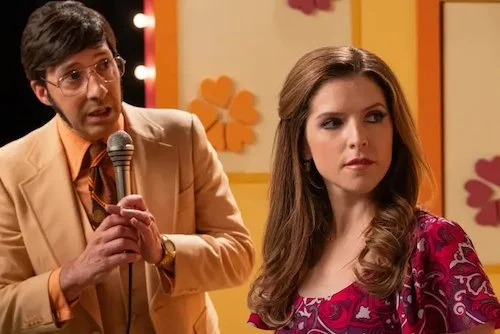Woman of the Hour
Written by Andreas Babiolakis
Warning: The following review for Woman of the Hour involves the discussion of topics like murder and sexual assault and violence. You may also find minor spoilers for the film in this review. Reader discretion is advised.
There’s an unofficial calculation that the odds of you crossing paths with a murderer can be one in 750 (this is centralized to the United States). You don’t necessarily have to see them in the act of killing (you may have even come across them before their crimes), but with the hundreds of thousands of murderers in the nation who have been convicted (and those who — not to alarm you — got away with their actions), these are the odds. While that spooky statistic is reason enough for a true crime film like Woman of the Hour to work (a case where a contestant on The Dating Game brushed paths with “eligible bachelor” — and serial killer — Rodney Alcala), actor-turned-director Anna Kendrick opts for something far more substantial with her filmmaking debut: an allegory on how women are silenced and ignored throughout the many years of civilization.
While promoting Woman of the Hour (a breakout film of TIFF 2023 which is finally making its theatrical and Netflix rounds a year later), Kendrick tipped her figurative hat to the Coen brothers and No Country for Old Men, stating that the neo-Western starts off with a set of grizzly murders through the character of Anton Chigurh, and this sets the tone of what the audience dreads will happen again throughout the remainder of the film; cleverly, No Country for Old Men conceals its biggest deaths from us, forcing us to conjure up a series of what-ifs in our mind (which Kendrick proclaims will always be scarier than anything a director will put to screen). Kendrick follows suit with Woman of the Hour: a close examination of Alcala’s various murders told in a broken order (and not chronologically). This allows audiences to focus on the handful of women Alcala (Daniel Zovatto) attacked and killed, given them opportunities to be remembered and recognized (all while setting the stage for how unpredictable Alcala is).
Furthermore, we see Alcala — a man — literally getting away with murder, and we notice the amount of women he has silenced forever. Kendrick’s point is that even the living women who want to report Alcala are neglected and not taken seriously, and we see that in a variety of scenarios. The main one is that of The Dating Game contestant Cheryl Bradshaw (Kendrick), who is advised to go on the show to further her career as an actor by getting noticed (the real Cheryl didn’t have such aspirations, but you’ll find that Kendrick and screenwriter Ian McDonald retool a lot to have Woman of the Hour get its point across). Cheryl is told by producers and game show host Ed Burke (Tony Hale, based on Jim Lange) to sit and smile and read the provided questions (essentially allowing the three male bachelors to shine more than her). At first, Cheryl complies before she remembers why she is there: to be noticed. She then puts on a show and outshines everyone, much to the chagrin of some of the other contestants (and very much the game show host, Ed).
While Cheryl shines, we see Alcala murder or kidnap women over the years. We learn how manipulative he is and pick up on his behaviours: the very kind he implements on The Dating Game to be selected by Cheryl. Seeing him just continue to get away with crime after crime is quite a frustrating ordeal in the way Kendrick presents his sequences, and that’s the point: she wants us to see what men have gotten away with while women have been thwarted in the mean time. One subplot involves Laura (Nicolette Robinson): a woman who is certain that Alcala got away with raping and murdering her best friend. She spots him at The Dating Game (as she is a member of the audience) and decides to try and take action by contacting the nearby security guard. Her plot thread had me the angriest because of how many men didn’t give her the proper time of day to help or listen; meanwhile, Alcala would go on to rape and kill after that evening.
Anna Kendrick doesn’t hold back with Woman of the Hour: a confident and fierce debut by the beloved actor.
All of Kendrick’s talking points lead to the bone-chilling climaxes that really put the title of the film into question: since it’s clearly a singular term, who is the woman of the hour? Is it Cheryl for being noticed and cherished on The Dating Game (on the very episode Alcala was on)? Without giving too much away, is it the final of Alcala’s victims that led to his arrest? What about the idea that there was always a new target, and that they were all the women of their respective (and, sadly, final) hours? Going back to the climax, I felt an overwhelming sense of fear much like one of the final sequences in David Fincher’s Zodiac: there’s a sense that we may watch our protagonists, who are within dangerous reach of harm, reach the same fate of the many fallen before them. Since Kendrick laid out the many ways Alcala gets his way, we begin to panic on Cheryl’s behalf: how will this moment turn out? Having this pseudo climax before the true one also helps as well, as if there is no way things will work out for the better; miracles can’t happen twice.
Having Cheryl be coached, dolled-up, and prepared for the viewing audience on The Dating Game, while a literal serial killer can just show up and exist on the same set, is a startling image that Woman of the Hour presents to us: a horrifying reality of how close in proximity women are to dangerous men at all times (and how effortlessly most of these men get away with what they do on a regular basis). The information revealed after the events of the film prove this, and Kendrick doesn’t try to soften the moment with triumphant, typical music or any Hollywood consoling. She instead allows our jaws to hit the floor when we get hit with the big facts about the Alcala case. She’s spent an hour and a half reinforcing how preventable most of these deaths were, and if this doesn’t infuriate you regarding how many innocent women were slain and not saved or protected (or, hell, even listened to), nothing will.
While there are moments when I felt the build up in Woman of the Hour was a little repetitive or meandering, I think Kendrick’s directorial debut is one of the strongest by a professional and celebrated actor in quite some time. This could have easily been a half-baked motion picture that worked with what it had and told this already astounding story as simplistically as possible. Kendrick wanted to prove a point with this preliminary vision. She knew what she wanted to say and commits to this purpose, while channeling the directors she learned from the most. While Kendrick is known for having such a bubbly persona in her most popular films (the Pitch Perfect and Twilight series, for starters), she makes one hell of a statement with what she chose to be her first film as a director and how she crafted the film: she is far more than what she is marketed to be.
I don’t even foresee another Bradley Cooper and A Star is Born with Kendrick and what she has shown with Woman of the Hour: I feel like she has even stronger capabilities, ideas, and techniques to the point of someone more bold and artistic like, say, a Brady Corbet (of Vox Lux and the upcoming The Brutalist fame): an actor who doesn’t just want to make films but would rather push what cinema can be instead. I think with a bit of extra time and additional foundation construction, Woman of the Hour could have been even stronger and Kendrick’s sense for slow-burning dread could have been even better realized. Knowing that there will likely be a next film and that it’ll have a larger budget and more for Kendrick to pull off and work with, I can only imagine what we’ll get next from a very promising newcomer within the filmmaking space; I’m hoping it’s sooner rather than later.
Andreas Babiolakis has a Masters degree in Film and Photography Preservation and Collections Management from Toronto Metropolitan University, as well as a Bachelors degree in Cinema Studies from York University. His favourite times of year are the Criterion Collection flash sales and the annual Toronto International Film Festival.






